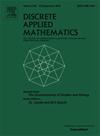Perfect matchings of (4,6)-fullerenes with largest forcing number
IF 1
3区 数学
Q3 MATHEMATICS, APPLIED
引用次数: 0
Abstract
Clar number (or resonant number) is a thoroughly investigated parameter of plane graphs emerging from mathematical chemistry to measure stability of some organic molecules. It was shown that the Clar number of a -fullerene graph , a plane cubic graph with only hexagonal and quadrilateral faces, is equal to its maximum forcing number . Let be any perfect matching of attaining the maximum forcing number. We use and to denote two largest sets of disjoint -alternating cycles and -alternating facial cycles respectively. Then . In this paper, we consider when holds. First we show that every cycle in has length 4, 6, 8 or 12. Then we construct two types of tubular -fullerene graphs and so that there is a containing a 12-cycle if and only if , and there is a containing a 8-cycle if and only if . As a consequence, we obtain the following three equivalent statements: (i) Each consists of 6-cycles and 4-cycles; (ii) ; (iii) .
具有最大强迫数的(4,6)-富勒烯完美匹配
克拉数(或称共振数)是数学化学中出现的用于测量某些有机分子稳定性的平面图参数。证明了(4,6)-富勒烯图G(一个只有六边形和四边形面的平面三次图)的克拉尔数等于它的最大强迫数F(G)。设M为达到最大强迫数的G的任意完美匹配。我们用C(G,M)和C(G,M)分别表示不相交的M交替循环和M交替面部循环的两个最大集合。那么F (G) = | C (G M) |≥C (G、M) | |。本文考虑当|C(G,M)|=|C(G,M)|成立。首先,我们证明C(G,M)中的每个循环的长度为4,6,8或12。然后构造了两类管状(4,6)-富勒烯图G1和G2,使得当且仅当G∈G1存在含12环的C(G,M),当且仅当G∈G2存在含8环的C(G,M)。因此,我们得到以下三个等价的表述:(i)每个C(G,M)由6个环和4个环组成;(2) | C (G、M) | = C (G、M) | |;(3) G∉G1∪G2。
本文章由计算机程序翻译,如有差异,请以英文原文为准。
求助全文
约1分钟内获得全文
求助全文
来源期刊

Discrete Applied Mathematics
数学-应用数学
CiteScore
2.30
自引率
9.10%
发文量
422
审稿时长
4.5 months
期刊介绍:
The aim of Discrete Applied Mathematics is to bring together research papers in different areas of algorithmic and applicable discrete mathematics as well as applications of combinatorial mathematics to informatics and various areas of science and technology. Contributions presented to the journal can be research papers, short notes, surveys, and possibly research problems. The "Communications" section will be devoted to the fastest possible publication of recent research results that are checked and recommended for publication by a member of the Editorial Board. The journal will also publish a limited number of book announcements as well as proceedings of conferences. These proceedings will be fully refereed and adhere to the normal standards of the journal.
Potential authors are advised to view the journal and the open calls-for-papers of special issues before submitting their manuscripts. Only high-quality, original work that is within the scope of the journal or the targeted special issue will be considered.
 求助内容:
求助内容: 应助结果提醒方式:
应助结果提醒方式:


